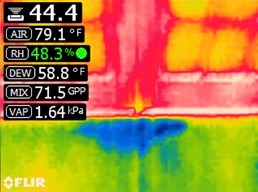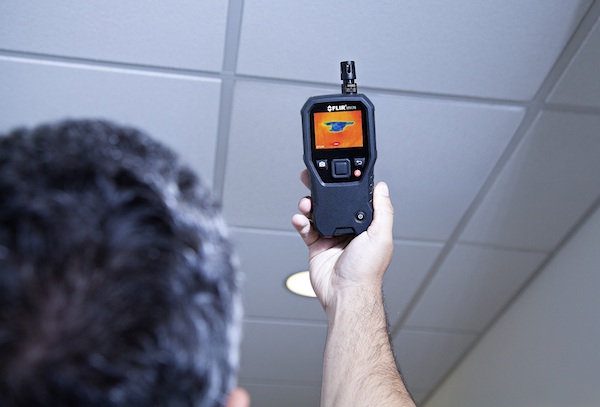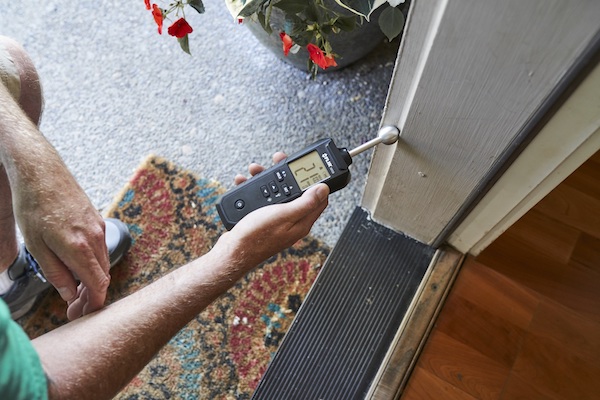By John Anderson, FLIR
Thermal imaging tools integrated with moisture meters can speed up the post-hurricane recovery process, improve repair quality, and add to contractor credibility. A thermal imaging camera can help you identify moisture areas faster and can lead to more accurate inspections with fewer call backs for verification by insurance companies. Many times, a good thermal image sent via email may be sufficient documentation to authorize additional work, leading to improved efficiency in the repair process.
Post-event process
 Contractors need to be able to evaluate water damage quickly and accurately after a hurricane or other storm event. This can be a challenge using traditional tools, especially pinless (non-invasive) moisture meters that offer a nondestructive measurement of moisture in wood, concrete and gypsum. Operating on the principle of electrical impedance, pinless moisture meters read wood using a scale of 5 to 30 percent moisture content (MC); they read non-wood materials on a relative scale of 0 to 100 percent MC. [1] While simple to use, identifying damage with any traditional moisture meter alone is a tedious process, often requiring at least 30 to 40 readings. And the accuracy of the readings is only as good as the user’s ability to find and measure all the damaged locations.
Contractors need to be able to evaluate water damage quickly and accurately after a hurricane or other storm event. This can be a challenge using traditional tools, especially pinless (non-invasive) moisture meters that offer a nondestructive measurement of moisture in wood, concrete and gypsum. Operating on the principle of electrical impedance, pinless moisture meters read wood using a scale of 5 to 30 percent moisture content (MC); they read non-wood materials on a relative scale of 0 to 100 percent MC. [1] While simple to use, identifying damage with any traditional moisture meter alone is a tedious process, often requiring at least 30 to 40 readings. And the accuracy of the readings is only as good as the user’s ability to find and measure all the damaged locations.
Using a thermal imaging camera along with a moisture meter is much more accurate. These cameras work by detecting the infrared radiation emitted by objects in the scene. The sensor takes the energy and translates it into a visible image. The viewer sees temperatures in the image as a range of colors: red, orange and yellow indicate heat, while dark blue, black or purple signifies colder temperatures associated with evaporation or water leaks and damage. Using this type of equipment speeds up the process and tracks the source of the leak—providing contractors with a visual to guide them and confirm where the damage is located. Even a basic thermal imaging camera, one that is used in conjunction with a smart phone, is far quicker and more accurate at locating moisture damage than a typical noninvasive spot meter.
Infrared Guided Measurement (IGM)
An infrared (IR) thermal imaging camera paired with a moisture meter is a great combination. The user can find the cold spots with the thermal camera and then confirm moisture is present with the moisture meter. This combination is widely used today, prompting FLIR to develop the MR176 infrared guided measurement (IGM™) moisture meter. This all-in-one moisture meter and thermal imager allows contractors to use thermal imaging and take moisture meter readings for a variety of post-storm cleanup tasks. These include inspecting the property, preparing for remediation, and—during remediation— assessing the effectiveness of dehumidifying equipment. The tool can also be used down the road after remediation to identify leaks that may—or may not—be related to the hurricane.

During the initial property inspection, the thermal imaging camera visually identifies cold spots, which are usually associated with moisture evaporation. Without infrared imaging, the user is left to blindly test for moisture—and may miss areas of concern altogether.
While preparing for remediation, a tool that combines a thermal imaging camera with a relative humidity and temperature (RH&T) sensor can provide contractors with an easy way to calculate the equipment they will need for the project. This type of tool measures the weight of the water vapor in the air in grains per pound (GPP), relative humidity, and dew point values. Restoration contractors know how many gallons of water per day each piece of equipment can remove and, using the data provided by the meter, can determine the number of dehumidifiers needed in a given space to dry out the area.
The dehumidifiers reduce moisture and restores proper humidity levels, preventing the build-up of air toxins and neutralizing odors from hurricane water damage. Since the equipment is billed back to the customer or insurance company on a per-hour basis, contractors must balance the costs with the need for full area coverage.

During remediation, moisture meters with built-in thermal imaging cameras provide key data that contractors can use to spot check the drying process and equipment effectiveness over time. In addition, thermal imaging can be used to identify areas that may not be drying as efficiently as others and can guide the placement of drying equipment.
The equipment is also useful after the fact, if, for example, contractors are looking to identify the source of small leaks that may or may not be related to the damage from the hurricane. Using a moisture meter/thermal camera combination can help them track the location and source of the moisture, as well as determine how much is remaining.
Remodeling contractors who need to collect general moisture data can benefit from thermal imaging moisture meters, as well. For example, tracing a leak back to its source can be a challenge. A leak in an attic may originate in one area of the roof and then run down into different parts of the structure. A moisture meter equipped with a thermal imager can help them determine where the leak actually started by tracing a water trail up the roof rafter to the entrance spot.
Choosing the right technology
A variety of thermal imaging tools are available, depending upon whether the contractor is looking for general moisture information, or needs more precise information on temperature and relative humidity levels.
For example, the FLIR MR176 IGM™ moisture meter with replaceable hygrometer is an all-in-one tool equipped with a built-in thermal camera that can visually guide contractors to the precise spot where they need to measure moisture. An integrated laser and crosshair helps pinpoint the surface location of the issue found with the thermal camera. The meter comes with an integrated pinless sensor and an external pin probe, which gives contractors the flexibility to take either non-intrusive or intrusive measurements.
Coupled with a field-replaceable temperature and relative humidity sensor, and automatically calculated environmental readings, the MR176 can quickly and easily produce the right measurements during the hurricane restoration and remediation process. Users can customize thermal images by selecting which measurements to integrate, including moisture, temperature, relative humidity, dew point, vapor pressure and mixing ratio. They can also choose from several color palates, and use a lock-image setting to prevent extreme hot and cold temperatures from skewing images during scanning.
Also available is the FLIR MR160, which is a good tool for remodeling contractors looking for general moisture information, for example, pinpointing drywall damage from a washing machine, finding the source of a roof leak that is showing up in flooring or drywall, as well as locating ice dams. It has many of the features of the MR176 but does not include the integrated RH&T sensor.
Capturing images with a thermal camera builds contractor trust and credibility
Capturing images of hurricane-related damage with a thermal camera provides the type of documentation that builds contractor credibility and increases trust with customers. These images help customers understand and accept contractor recommendations. Credibility increases when customers are shown images demonstrating conclusively why an entire wall must be removed and replaced.
When customers experience a water event, proper photo documentation can bolster their insurance claims. The inclusion of thermal images will definitely improve insurance payout outcomes and speed up the process.
Post-storm cleanup tool for the crew
By providing basic infrared imaging functions, in combination with multiple moisture sensing technologies and the calculations made possible by the RH&T sensor, an imaging moisture meter such as the MR176 is a tool the entire remediation crew can carry during post-storm cleanup.
References
[1] Types of Moisture Meters, https://www.grainger.com/content/qt-types-of-moisture-meters-346




Join the conversation: